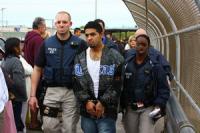-
Europe Built a System to Fight Russian Meddling. It’s Struggling.
The European Union launched an ambitious effort earlier this year to combat election interference: an early-warning system that would sound alarms about Russian propaganda. Despite high expectations, however, records show that the system has become a repository for a mishmash of information, produced no alerts and is already at risk of becoming defunct.
-
-
Venezuelan government's death squads kill thousands: UN

A UN report published Thursday has detailed the extrajudicial executions of thousands of young men by the special forces of the government of Nicolas Maduro in Venezuela. The report offers evidence that that the Venezuelan government’s death squads are carrying out Maduro’s broad strategy for neutralizing the opposition to his regime and eliminating political opponents.
-
-
IAEA confirms Iran enriching uranium in excess of 2015 nuclear deal limit

The United Nations atomic watchdog agency has confirmed that Iran has surpassed the limits on how much it was allowed to enrich uranium under the 2015 international nuclear deal. The International Atomic Energy Agency said its inspectors verified Monday that Iran has passed 4.5 percent enrichment, breaching the 3.67 percent limit set in the accord aimed at restraining Tehran’s nuclear weapons development.
-
-
U.S. Designates Chief of Hezbollah’s Intelligence Unit as a “Global Terrorist”
The United States announced last Tuesday that it has identified Husain Ali Hazzima, a senior Hezbollah operative, as a Specially Designated Global Terrorist (SDGT). Meanwhile, a new intelligence assessment released by the German state of North Rhine-Westphalia revealed on Thursday that the number of Hezbollah operatives in Germany rose in 2018.
-
-
Huawei CVs Show Close Links with Military, Study Says
A study of the employment information of thousands of Huawei staff has revealed deeper links with the Chinese military and intelligence apparatus than those previously acknowledged by China’s biggest telecom equipment maker. The findings are likely to add fuel to the debate among governments around the world over whether to block Huawei’s gear from the rollout of 5G telecoms networks for security reasons.
-
-
Could Secret Cables Have Saved Ethel Rosenberg From the Electric Chair?
At 8:11 on the evening of June 19, 1953, Ethel Rosenberg was strapped into the electric chair at the New York State prison known as Sing Sing. Even as Ethel Rosenberg was strapped into the electric chair for spying for Moscow, decrypted cables might have spared her. But they were released only decades later.
-
-
Transnational Organized Crime and National Security: Hezbollah, Hackers and Corruption
American law enforcement efforts have become increasingly multifaceted as the government attempts to combat the continuing ingenuity and sophistication of transnational organized criminal groups. Eric Halliday writes in Lawfare that the U.S. government has announced several significant actions taken against transnational organized crime groups. The Treasury Department’s Office of Foreign Assets Control (OFAC) promulgated a slew of sanctions against the financial networks of both Hezbollah and Cártel de Jalisco Nueva Generación (CJNG). The Justice Department announced takedowns of drug trafficking rings spanning the U.S. and Mexico as well as a large-scale organized cybercrime ring composed of members from several Eastern European countries.
-
-
Why Terrorists Sometimes Apologize for Their Actions

Armed groups often rely on violence and instilling fear to show strength and resilience. And yet, every so often, they are willing to apologize when things go wrong. The New IRA recently apologized for killing Lyra McKee, an investigative journalist, during a riot in Derry. The group’s targets, which they described as “enemy forces,” were officers of the Police Service of Northern Ireland. As scholars of conflict, we both study a variety of armed groups, from nationalist and separatist liberation movements to Islamist opposition groups. Ioana Emy Matesan and Ronit Berger write in the National Interest that over time, comparing anecdotes turned into a systematic investigation of armed attacks, in order to address an understudied question: Do rebel groups ever apologize for their mistakes? If such groups were ever willing to apologize for their actions, we wanted to understand when and why they would do so. We hoped it would help us find ways to negotiate resolutions during conflicts.
-
-
How Fake News Could Lead to Real War
Who really bombed the oil tankers in the Persian Gulf two weeks ago? Was it Iran, as the Trump administration assured us? Or was it Saudi Arabia, the United Arab Emirates or Israel—or some combination of the three? Daniel Benjamin and Steven Simon write in Politico that they believe in the official U.S. position, that Iran was behind the attacks, trying to prod other countries to pressure the U.S. to relax its sanctions makes sense. But the whole unsettling episode opened our eyes to a deeply troubling reality: The current fake news epidemic isn’t just shaking up U.S. politics; it might end up causing a war, or just as consequentially, impeding a national response to a genuine threat. Thus far, public discussion of deep fakes—and fake news more broadly—has focused on domestic politics and particularly elections. That was inevitable after the Russian interference on President Donald Trump’s behalf in 2016—the dimensions of which were laid out in the unprecedented joint assessment of the National Security Agency, Central Intelligence Agency and Federal Bureau of Investigation in February 2017 and the Mueller Report.
But fake news’ implications for foreign and security policy may be as far-reaching—and even more dangerous. Misinformation in geopolitics could lead not only to the continued weakening of our institutions but also to combat deaths. Sure, fake news has been a feature of international relations for a long time, but it’s different now: “Advancing technology that can fabricate convincing images and videos combined with the chronic, exuberant dishonesty of the commander-in-chief and his minions has meant that no one can feel confident in assessing life or death choices in foreign policy crisis. For a democracy—one with global interests—this is a disaster,” Benjamin and Simon write. -
-
Pentagon Report: Russian Leaders Believe They Are Already at War with the United States—in the Gray Zone

A group of governmental, military, and outside experts published a white paper urging the US government to jump fully into the so-called gray zone—the conceptual space in which countries take action that lies somewhere on the continuum between warfare and peaceable relations. Russia, they say, is exploiting it effectively. It’s in the gray zone that Russia meddles with elections, launches online disinformation campaigns, and uses a host of other means to gain greater leverage in places ranging from the former Soviet states to Latin America. Matt Field, writing in the Bulletin of the Atomic Scientists, notes that Russia’s already doing well in this sub-military conflict space. He quotes Nicole Peterson, who writes in the report’s executive summary: “Overall, Russia’s influence abroad is growing, and the Kremlin has mastered the use of ‘hybrid warfare’ in driving Russia’s foreign policy… Russia utilizes a variety of gray zone tactics around the globe. These include the use of paramilitary forces and other proxies, interference in political processes, economic and energy exploitation (particularly in Africa), espionage, and media and propaganda manipulation.”
-
-
Europe Built a System to Fight Russian Meddling. It’s Struggling.
The European Union launched an ambitious effort earlier this year to combat election interference: an early-warning system that would sound alarms about Russian propaganda. Despite high expectations, however, records show that the system has become a repository for a mishmash of information, produced no alerts and is already at risk of becoming defunct. Matt Apuzzo writes in the New York Times that Europe’s early struggles offer lessons for other nations, including the United States, where intelligence officials expect Russia to try to interfere in next year’s presidential election. In many ways, the European Union has been more aggressive than Washington in demanding changes from social media companies and seeking novel ways to fight disinformation. Efforts to identify and counter disinformation have proven not only deeply complicated, but also politically charged.
-
-
Could Secret Cables Have Saved Ethel Rosenberg From the Electric Chair?
At 8:11 on the evening of June 19, 1953, Ethel Rosenberg was strapped into the electric chair at the New York State prison known as Sing Sing. She was 37 years old and the mother of two young sons. The chair, made of oak and iron, had killed hundreds of convicted criminals over the years, including her husband, Julius Rosenberg, a few minutes before. But the chair was not always reliable, which was one reason inmates gave it the cynical name “Old Sparky.” Christopher Dickey writes in the Daily Beast that two years earlier, when both Rosenbergs were convicted of spying for Moscow, Federal Judge Irving R. Kaufman had handed down their death sentences. The Rosenbergs’ crime, he said, was “worse than murder.” But in fact the penalty was not about justice. It was about vengeance for a loss the American public felt was so enormous that someone must be made to pay a horrible price. It was “as if a society turned its magnifying lens on these people until they caught fire and were burned alive,” said novelist E. L. Doctorow, whose The Book of Daniel was a fictional account of the case. “Even as Ethel Rosenberg was strapped into the electric chair for spying for Moscow in 1953, decrypted cables might have spared her. But they were released only decades later,” Dickey writers.
-
-
Huawei CVs Show Close Links with Military, Study Says
A study of the employment information of thousands of Huawei staff has revealed deeper links with the Chinese military and intelligence apparatus than those previously acknowledged by China’s biggest telecom equipment maker. The findings are likely to add fuel to the debate among governments around the world over whether to block Huawei’s gear from the rollout of 5G telecoms networks for security reasons. Kathrin Hille writes in the Financial Times that The findings are likely to add fuel to the debate among governments around the world over whether to block Huawei’s gear from the rollout of 5G telecoms networks for security reasons. “Huawei has gone to great lengths saying they have no links with the Chinese military and security institutions,” said Prof. Balding. “The narrative they spin is false — military connections quite clearly run deep.” Analysts said the systemically close ties documented in the study reflected a pattern far beyond Huawei. One expert said such sharing or co-ordination of personnel across defense and commercial research activities was consistent with China’s national strategy for military-civil fusion.
-
-
DHS Chief Orders Probe of Agents' Offensive Facebook Posts

DHS secretary on Wednesday ordered an immediate investigation into a report that current and former U.S. Border Patrol agents are part of a Facebook group that posts racist, sexist and violent comments about migrants and Latin American lawmakers.
-
-
Mexicans in U.S. Routinely Confront Legal Abuse, Racial Profiling, ICE Targeting and Other Civil Rights Violations

Officially, the Constitution of the United States gives everyone on U.S. soil equal protection under the law – regardless of nationality or legal status. But, as recent stories of the neglectful treatment of migrant children in government detention centers demonstrate, these civil rights are not always granted to immigrants.
-
More headlines
The long view
What Does Netflix’s Drama “Adolescence” Tell Us About Incels and the Manosphere?
While Netflix’s psychological crime drama ‘Adolescence’ is a work of fiction, its themes offer insight into the very real and troubling rise of the incel and manosphere culture online.
A Shining Star in a Contentious Legacy: Could Marty Makary Be the Saving Grace of a Divisive Presidency?
While much of the Trump administration has sparked controversy, the FDA’s consumer-first reforms may be remembered as its brightest legacy. From AI-driven drug reviews to bans on artificial dyes, the FDA’s agenda resonates with the public in ways few Trump-era policies have.
The Center Can Hold — States’ Rights and Local Privilege in a Climate of Federal Overreach
As American institutions weather the storms of executive disruption, legal ambiguity, and polarized governance, we must reexamine what it means for “the center” to hold.
How to Reverse Nation’s Declining Birth Rate
Health experts urge policies that buoy families: lower living costs, affordable childcare, help for older parents who want more kids
Foundation for U.S. Breakthroughs Feels Shakier to Researchers
With each dollar of its grants, the National Institutes of Health —the world’s largest funder of biomedical research —generates, on average, $2.56 worth of economic activity across all 50 states. NIH grants also support more than 400,000 U.S. jobs, and have been a central force in establishing the country’s dominance in medical research. Waves of funding cuts and grant terminations under the second Trump administration are a threat to the U.S. status as driver of scientific progress, and to the nation’s economy.
The True Cost of Abandoning Science
“We now face a choice: to remain at the vanguard of scientific inquiry through sound investment, or to cede our leadership and watch others answer the big questions that have confounded humanity for millennia —and reap the rewards.”
